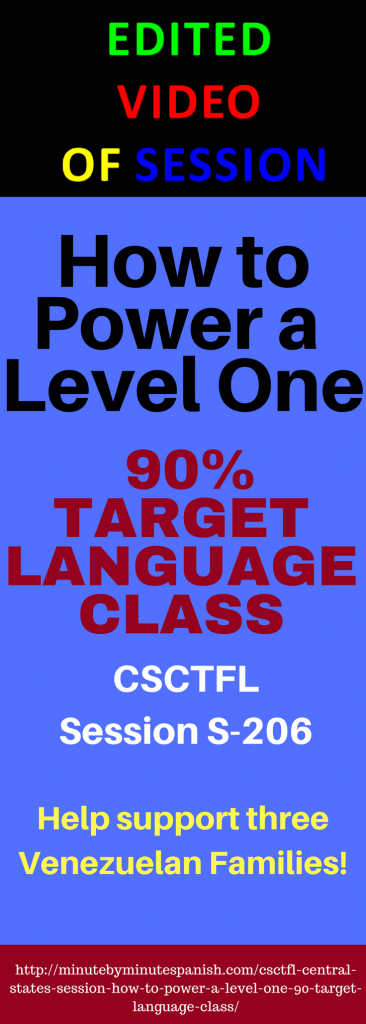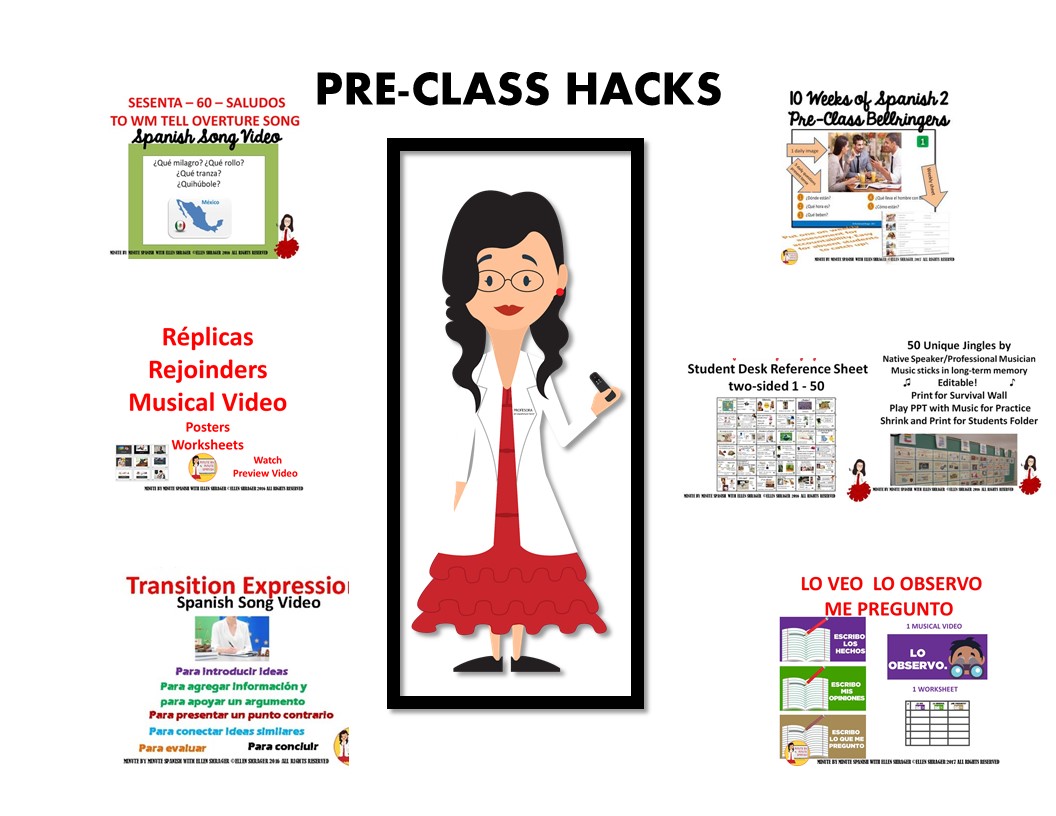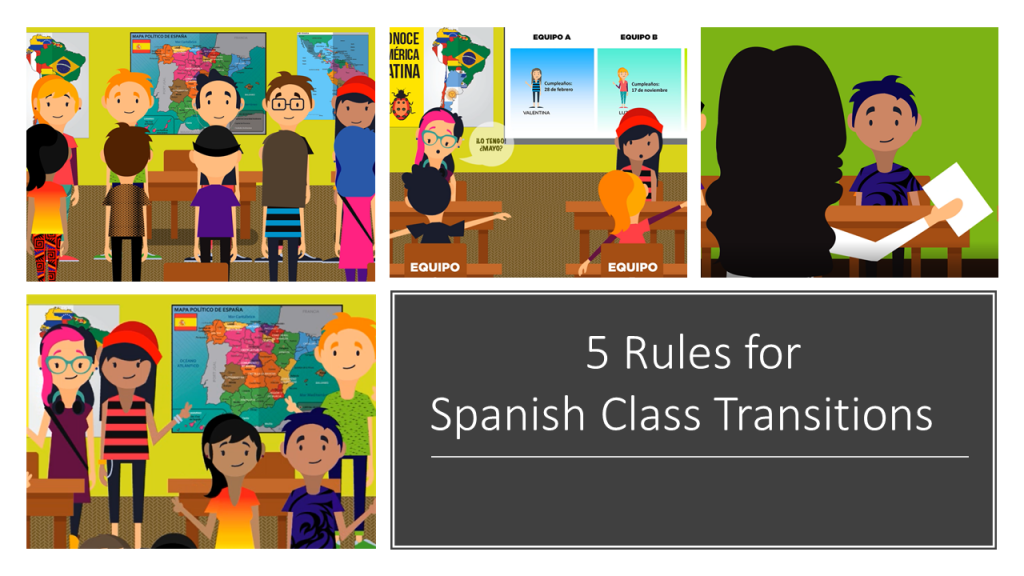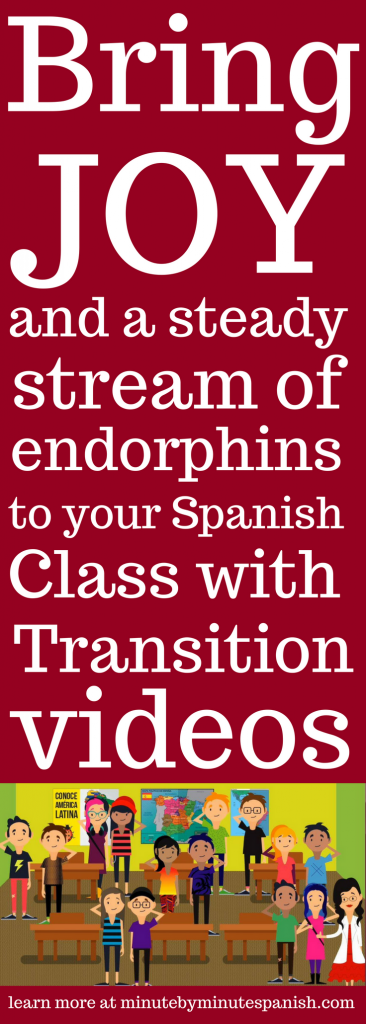
Stay on Task and in the target language with transition videos.
Spanish Lessons

Stay on Task and in the target language with transition videos.
Handout for central states 2018 Friday S-206



As we head back to our classrooms, it is time to decide the best way to start our language class.
It really depends on our schedule because the year we teach the same class three times a day in the same room without having to share it with another teacher is very different from the year we are moving room to room or switching subjects/languages that we teach.
With the former, I play the “day of the week” song so that as students walk in they are switching to their target language and commenting on their reaction to it being Friday or Tuesday using the words in the song to express themselves.
I have it and my lesson in a daily slide show and all songs play as soon as I click to the next slide. I use a remote presentation device for this – I can be out in the hall doing this and the slide will change!

When I am ready to start class, I use my remote clicker to play the count down song and students enjoy counting down as everyone must be seated before it ends.
I click into the class greetings slides with the daily calendar video and taking attendance routine video. And we are off! This routine works so well that teachers in six other languages have adapted them and are also available – see below.
But when I float or am switching gears from teaching a different subject and need a few extra minutes, then my students know to take out their weekly “bellringer” sheets, or open to them on their Google Drives.
I have six kinds of “bellringer” and they all involve music. Students are listening to a native speaker while I take care of administrative tasks.
_1_Instructional Video – Lo veo – Paper from ellen shrager on Vimeo.
Spanish Two Pre-Class Bellringers with level1 Questions 10 weeks low prep from ellen shrager on Vimeo.
Students feel safe when they know what to do but are curious as to which picture will be used today. It is the right blend of routine and innovation. Give yourself a bit of grace starting each class with one of these and not stress about taking care of your administrative tasks while the students are engaged.
Spanish Rejoinders Replicas Musical Video from ellen shrager on Vimeo.
Spanish AP Upper Level Writing Transition Words from ellen shrager on Vimeo.
4-saludos-y-hola2 from ellen shrager on Vimeo.
Students feel safe when they know what to do but are curious as to which picture will be used today. It is the right blend of routine and innovation. Give yourself a bit of grace starting each class with one of these and not stress about taking care of your administrative tasks while the students are engaged.
These videos are available in other languages.
Click here for Italian videos.
Click here for Mandarin videos


Don’t blame the parents or the students! Blame social media surrounding our middle school students with the belief that every opinion is important and demanding of immediate attention. The village needs to directly teach children and their parents to stop this or else the students will not deserve an excellent Teacher Evaluation when applying to colleges.
In case the parents don’t know, over 700 universities accept the Common Application. Its Teacher Evaluation will be important and students really don’t know who in their senior year they will be asking to complete it. Acting like jerks in ninth grade study hall may prevent students from getting the kind of recommendation they need. I described this in detail in books for parents and a book for teachers. If you want the whole explanation and create a paradigm shift with your community, consider using these books: Seventh Grade Guide Sixth Grade Guide Teacher Dialogues
But if you just want the 10 minute explanation it goes like this. Pick a time to have a heart-to-heart talk with your class. Explain that their speaking out, whining, and interrupting, is becoming a habit that must now be broken in middle school because their high school teachers will be judging them and evaluating them. Even if they think they will grow up when they are juniors – their senior teachers may have had them in a study hall or lunch room duty when they were freshmen. Even if they are marked as being good – they are in column 5 of 7 – and not the best candidates. The margin is very slender. Show them the four areas indicated with the arrows that concern you. Tell them that they have a great future, but not if they don’t have the social skills desired by adults writing and reading the college applications.
This usually stops students and parents. I tell them that I will do my job by reminding them with the words, “social skills alert” meaning their lack of appropriate social skills is a problem. I call their parents and tell them that I am doing this to help them and ask for their help. I assure the students and their parents that this is so important that I am willing to assign detentions and work with their parents to get them back on track.
As for Spanish class, I have created three musical videos to demonstrate these skills. The first is how to treat a new student in class. The second is how to write an email to a teacher, and the third is the most important, asking if now is a good time before just talking at the teacher with different requests.
As I write these words in March, I see many teachers writing about classroom management beginning to unravel. Point systems are all about external validation that quickly loses its attraction and the external rewards need to be upped as time goes on. There is no magic bullet that will last the year. External rewards only last so long.
But internal validation is something else. It’s about catching their vision of who they want to be and showing how developing self-discipline will get them there. Connect with your students by sharing this information with them and their parents and relating their behavior choices to their future ability to have the things they want and the lifestyle they deserve.



A student studying to be a Spanish teacher asked, “What frase in the target language should I use to get their attention when transitioning to an new activity?”
The shallow answer is “¿listos o no listos?” My students answer in unison “listos” and occassionaly in a playful mood they will tell me “no listos” and I will tell them “no es la respuesta correcta” and we try again and move on.
Transitions can make or break classroom management and a one-size-fits-all approach is a common pitfall for new teachers. As a reflective teacher in her 30th year in the secondary classroom, I have 5 rules for world language class transitions.
1. Do not try to get the class to be quiet, rather you want them to be attentive. Students respond better to giving you a reply than to hushing. Create responses for them and they will all join in.
2. Do not get their attention until you are 110% prepared with the next activity. Getting their attention and then fumbling for the location of the handouts or the track on the CD or link to the video is deadly to classroom management. You will loose them and their attentiveness for future transitions, as they figure you don’t really mean it . . . yet.
3. Support your transitions with a visual, assuming you can project on to a screen or wall. I make a daily tech guide with a slide for each activity and each transition so that the students look up and know what to do even if they can’t quite hear you above all the paired practice speaking going on around them. Make a list of your weekly activities, make a slide for each one and a transition for each one. Use a remote presentation device or wireless mouse so you can stand near certain students while you transition through the class. Click here for videos of my tech-guided classes.
4. If you are using music or a video, embed them in your daily tech guide. This extra prep work will pay large dividends as you minimize down time.
5. Use musical transition videos. Over 50 of them were made by some fairly desperate Venezuelans and all proceeds go to them. They have created the best atmosphere for my level one classes, students delighting in the musical breaks and singing along as they do the transition. My transitions are now seamless.
2023 Update: Check just prep during your prep here – we now have over 100 videos.
Get a free version here.
Scroll down this previous post to get a feel for them – there are examples in six languages. They are a game changer!
1. When I am ready to start, I play the class count down video – students know to be seated and quiet as they count down the 3 -2 – 1 ya! French version below!
Students use this expression spontaneously before beginning anything.
2 I greet them, ask how they are, and tell them the objective of the day and the class activities of the day – all on 3 slides. I play the “Take out the Homework” video and show the answers on the board while I quickly check for completion. Since day two of the school year when I first played it, my students spontaneously tell me ‘la tengo’ or ‘no la tengo’ and if someone doesn’t have it everyone else asks, “¿en serio?”
3. Check for questions and play the musical slide to take attendance – we get nasty emails if we miss attendance for any class! My students tell me” X está ausente” or “no está ausente, en el baño.”
4. Play “The Daily Review”song and complete five minutes of review. My Spanish 1 students can fluently say “cuando necesito gramática perfecta” and “¿Qué hago – repaso, repaso, repaso”
5. Play “Take Out the Vocab List video and they can all mimic “Favor de sacar la lista del vocabulario.”
I also play the self- talk musical slide that reminds students if they don’t get it right to tell them selves – I don’t have it yet! I introduce a chunk of vocabulary, practice comprehension with gestures and then show slides with visuals. My Spanish 1 students use “lo acerté spontaneously in many situations” and even “no lo acerté – todavía.”
6. Play the video about finding a random partner of the week or if we already did it play the musical slide to find this week’s partner.
My students can say ¿Quién sera? even though they won’t be taught this tense for three more years.
7. Practice with partner(s) usually some kind of spontaneous speech activity – there are videos that show the students how to play guessing games. If we have the computers then they will watch “The Take Out the Computer” video, “Practice QuizletLive” video, students practice on their own, play the quizlet live video and finally I play the “Put Away the Computers” video and rearrange the chairs slide. My students quickly learn the games that have songs to teach the vocabulary and create spontaneous dialogues – month two of Spanish One! They can all do “más alto, más bajo” and many others.
8. Slide leading into next activity – could be a listening activity or a reading activity or Simon says. My students all know “vamos a jugar” and can follow it with many games.
9. Tidy up the room.
_13 Que desorden Pls no posting – trimmed from ellen shrager on Vimeo.
10.Take out the Agenda video and students write down the homework. My students can say any line from this song at appropriate times.
“ay no me gusta, pero es importante” “Saco mi agenda, escribo la tarea.”
_20 Saco Mi Agenda Pls no posting – trimmed from ellen shrager on Vimeo.
11. Closure – students sing and then tell me something new they learned. My students can spontaneously say “Hoy, hoy aprendi ” and complete the thought.
Video 69 Señora – trimmed from ellen shrager on Vimeo.
My public school seventh, eighth, and ninth graders in Spanish One produce spontaneous speech even if they don’t want to – they can’t help themselves because music enters their brains and remains like nothing else that I have tried in these past 30 years. You can make your own songs or use mine.
You can even use my videos, created by native speakers, and offered here on TeacherspayTeachers. Or click here for the starter kit! They help support several Venezuelan families. We are making them in French, Mandarin, German, and Latin, and English. What I love about TeacherspayTeachers is that it helps new teachers to quickly climb the learning curve by selecting tried and true activities from veteran teachers still in the classroom, like me! If you need something new to get your students spontaneously speaking in the target language – this is it!
Click here for Italian videos.
Click here for Mandarin videos



 Something is afoot in my Spanish classroom this year. For the first time in 30 years, students walk in sighing with relief that they are in room 363 because it is so “chill” in here.
Something is afoot in my Spanish classroom this year. For the first time in 30 years, students walk in sighing with relief that they are in room 363 because it is so “chill” in here.
Every fifty-minute period we go through about 8 activities on 100 slides with no gaps or down time. One new student mistakenly thought he had stumbled into an Honors class because of all we do. We aim for 90% target language from day one – past students confided their first month was stressful. Current students express their relief and joy at being in my class. Joy!
There are over 20 million entries in Google for “Fun Spanish Class Activities” but there are only four for “Joy in the Spanish Class”
Fun activities are the preterit tense with defined beginnings and endings.
Joy is the flowing imperfect tense with no defined ending.
Fun is external. Joy is internal
One fun activity for the past 20 years has been our “Song of the Week.” Students love the five minutes of the class devoted to wonderful songs. This year is different. To keep students in the target language and on task, I developed transition videos. The unintended consequence is that they make students feel joyful!
According to http://www.emedexpert.com/tips/music.shtml music is powerful.
Music enhances intelligence, learning, and IQ.
Music fights fatigue.
Music calms and relaxes.
Music improves memory performance.
Music reduces stress and aids relaxation.
Music improves mood and decreases depression.
Music is a great anti-anxiety remedy.
As my students walk in each day they hear “the day song” and soon they are using the words to express their feelings.
1. When I am ready to start, I play the class count down video – students know to be seated and quiet as they count down the 3 -2 – 1 ya! French version below!
Students use this expression spontaneously before beginning anything.
2 I greet them, ask how they are, and tell them the objective of the day and the class activities of the day – all on 3 slides. I play the “Take out the Homework” video and show the answers on the board while I quickly check for completion. Since day two of the school year when I first played it, my students spontaneously tell me ‘la tengo’ or ‘no la tengo’ and if someone doesn’t have it everyone else asks, “¿en serio?”
3. Check for questions and play the musical slide to take attendance – we get nasty emails if we miss attendance for any class! My students tell me” X está ausente” or “no está ausente, en el baño.”
4. Play “The Daily Review”song and complete five minutes of review. My Spanish 1 students can fluently say “cuando necesito gramática perfecta” and “¿Qué hago – repaso, repaso, repaso”
5. Play “Take Out the Vocab List video and they can all mimic “Favor de sacar la lista del vocabulario.”
I also play the self- talk musical slide that reminds students if they don’t get it right to tell them selves – I don’t have it yet! I introduce a chunk of vocabulary, practice comprehension with gestures and then show slides with visuals. My Spanish 1 students use “lo acerté spontaneously in many situations” and even “no lo acerté – todavía.”
6. Play the video about finding a random partner of the week or if we already did it play the musical slide to find this week’s partner.
My students can say ¿Quién sera? even though they won’t be taught this tense for three more years.
7. Practice with partner(s) usually some kind of spontaneous speech activity – there are videos that show the students how to play guessing games. If we have the computers then they will watch “The Take Out the Computer” video, “Practice QuizletLive” video, students practice on their own, play the quizlet live video and finally I play the “Put Away the Computers” video and rearrange the chairs slide. My students quickly learn the games that have songs to teach the vocabulary and create spontaneous dialogues – month two of Spanish One! They can all do “más alto, más bajo” and many others.
8. Slide leading into next activity – could be a listening activity or a reading activity or Simon says. My students all know “vamos a jugar” and can follow it with many games.
9. Tidy up the room.
_13 Que desorden Pls no posting – trimmed from ellen shrager on Vimeo.
10.Take out the Agenda video and students write down the homework. My students can say any line from this song at appropriate times.
“ay no me gusta, pero es importante” “Saco mi agenda, escribo la tarea.”
_20 Saco Mi Agenda Pls no posting – trimmed from ellen shrager on Vimeo.
11. Closure – students sing and then tell me something new they learned. My students can spontaneously say “Hoy, hoy aprendi ” and complete the thought.
My public school seventh, eighth, and ninth graders in Spanish One produce spontaneous speech even if they don’t want to – they can’t help themselves because music enters their brains and remains like nothing else that I have tried in these past 30 years. You can make your own songs or use mine.
You can even use my videos, created by native speakers, and offered here on TeacherspayTeachers. Or click here for the starter kit! They help support several Venezuelan families. We are making them in French, Mandarin, German, and Latin, and English. What I love about TeacherspayTeachers is that it helps new teachers to quickly climb the learning curve by selecting tried and true activities from veteran teachers still in the classroom, like me! If you need something new to get your students spontaneously speaking in the target language – this is it!
Click here for Italian videos.
Click here for Mandarin videos
Explore your Spanish options from this Pinterest Board.


| Cookie | Duration | Description |
|---|---|---|
| cookielawinfo-checkbox-analytics | 11 months | This cookie is set by GDPR Cookie Consent plugin. The cookie is used to store the user consent for the cookies in the category "Analytics". |
| cookielawinfo-checkbox-functional | 11 months | The cookie is set by GDPR cookie consent to record the user consent for the cookies in the category "Functional". |
| cookielawinfo-checkbox-necessary | 11 months | This cookie is set by GDPR Cookie Consent plugin. The cookies is used to store the user consent for the cookies in the category "Necessary". |
| cookielawinfo-checkbox-others | 11 months | This cookie is set by GDPR Cookie Consent plugin. The cookie is used to store the user consent for the cookies in the category "Other. |
| cookielawinfo-checkbox-performance | 11 months | This cookie is set by GDPR Cookie Consent plugin. The cookie is used to store the user consent for the cookies in the category "Performance". |
| viewed_cookie_policy | 11 months | The cookie is set by the GDPR Cookie Consent plugin and is used to store whether or not user has consented to the use of cookies. It does not store any personal data. |